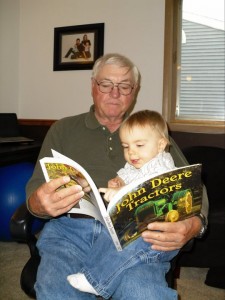When Bob was having trouble with the combine, he left some ears of corn on the ground in the field. As I walked out there to talk to him, I picked up some until my arms were full. This little gleaning act brought back memories from my childhood that I’ll share here today.
When I turned 14 my parents bought me a small horse named Goldie. At that time we also had a pony named Snicker and assorted poultry. All of our livestock ate corn. Back then money was in short supply. Mom bought feed, but to help make it stretch further, we gleaned.
Across from our two and a half acres, was a field of corn. During late summer, when the stalks were tall, we would play hide and seek out there with our cousins. I remember crossing rows until I was far enough ahead of Georgie, then lying down flat as possible in hope that he wouldn’t see me. (Giggling usually gave me away.) We took care not to flatten any of the plants, but it was a neat place to have adventures.
When harvest time arrived, we watched as the farmer combined his crop. His machine did an okay job, but left ears behind. Dad talked to him and the farmer said we could take any corn left on the ground. A new chore was added to our list of things to do.
Since the corn mostly went to my horse, and eventually to my sister’s horse when she got Penny, we were expected to do the gleaning. Dad worked nights, so he wasn’t out there much with us, but Mom was.
After school or on weekends, my sister Karen and I would grab empty burlap bags and head out to the field. We walked the rows, picking up the ears and filling the bag until it was too heavy to drag any more. After we had a few full, or at least as full as we could handle, we left them where they were and went back to the barn. – If my memory is right, sometimes we threw a cob or two at the other sister when she wasn’t looking. That was our way of making a boring job exciting.
Goldie was enlisted to help bring the bags home. I strapped on her harness, hooked her up to a two-wheel cart and then my sister and I rode the cart back to the field.
Getting the bags of corn into the cart wasn’t easy, but we managed. When everything was loaded, there wasn’t room for us, so we walked home leading the horse.
When we got back to the barn, sometimes Dad would help dump the corn into a big wood box. — We called it the coffin box because at one time empty coffins had been shipped in it. That box worked great for grain storage even if a mouse found its way into it here and there. The only real trouble came when the coffin box was nearly empty.
I hated reaching down into that dark, empty box. It didn’t help that on numerous occasions, when I was leaning and reaching in, Karen tried to upend my legs, dump me inside and close the lid. – Ha ha, very funny, Karen. – Of course, I tried to do the same to her the very next day, but that doesn’t count because I was just trying to get even.
Anyway, all fall, until the first snows came, we all worked at bring home that corn. Mom didn’t sit on the sidelines, either. When we kids were in school, Mom took empty bags out to the field and filled them on her own, working hard by herself. After school, horse and cart were put to use again. Mom never harnessed Goldie to the cart. She waited for me to do that, but that was the easy part. Picking the corn wasn’t.
None of this was easy work, but if we wanted our large pets, it was only right that Karen and I helped gather their food. The corn was free after all. It would have been a sin to just leave it out there to rot.
When our children were young, I remember taking all four out to glean, too. It didn’t work the same with them. Mostly I heard grumbling. “Robby’s in my row taking my corn!” “Can’t Becky stay over there?” “I didn’t mean to hit you in the head with the ear. It slipped.” When I marched them back to the house, we didn’t have much corn, but I did have a whopper of a headache.
Now we have some ear corn left on the ground in the field and I wonder if anyone is out there who needs it. Are there teenagers with horses that they love so much that they would actually work to bring in their feed? If that’s you, give us a call. We’re in the telephone book. Bob and I will point you to the best place to glean. There are no burlap bags here, but we have some plastic bags you can have. Better hurry before we get snow.
